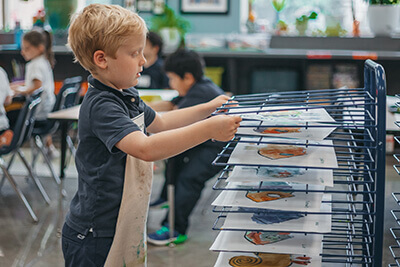September 21, 2023
 from Dr. Bill Hudson, head of school
from Dr. Bill Hudson, head of school
Rarely was I more proud of our school than last Thursday. I sat in on the presentation of our Lower School specialist teachers at Curriculum Night. Our teachers presented the underpinnings of their curriculum with passion and upon a firm foundation of science and best practices. Across divisions, the MPA curriculum is enriched by a commitment to the arts and a whole child pedagogy.
In an age of high-stakes standardized testing and societal concerns about math and science scores, parents might question MPA’s emphasis on the arts. I understand the arts at MPA more broadly, including music (vocal and instrumental), visual arts, theater, and even world languages and physical education. From the founding of the school, the curriculum of the school reflects an intentional balance between academics, arts, and athletics. 1982, our founders knew instinctively that such a balance was vital to developing the whole child. Through new and emerging brain research, we now know that their instincts were correct.
Over the weekend, I read the New York Times bestseller Your Brain on Art: How the Arts Transform Us by Susan Magsamen and Ivy Ross. The authors propose that the arts are not mere distractions but powerful tools for improving our health and well-being across many dimensions of life and with the science to prove it. The arts are vital in relieving stress and enhancing well-being; they help heal trauma, mitigate pain, and help us live not only a healthier life but a longer and more meaningful life, too.
While it is impossible to share all the research in this brief message, it can be stated simply that the arts “trigger the release of neurochemicals, hormones, and endorphins, that in turn affect physiology and behavior.” Neuroplasticity, the brain’s ability to rewire itself, is fueled by the arts that help build and strengthen synaptic connections.
Time spent in the arts, physical education, and world language do not detract from time in reading, literacy, science, and math. Studies demonstrate that sustained learning in the arts correlates with higher academic achievement. Neuroscientist Dr. Assal Habibi of the University of Southern California found that “when young musicians performed intellectual tasks, they demonstrated greater engagement of a brain network involved in executive function and decision-making. It also enhances memory, spatial reasoning, and literacy skills.
The arts tap into our need to understand, to be moved, and to be comfortable with ambiguity. Art is a vehicle of curiosity and creativity. I remember a conversation years ago with an MPA alum who was a successful software engineer. When I asked him how MPA prepared him for success in his field, I expected him to say the math and science programs. Instead, he said it was photography that enhanced his curiosity and creativity. The arts fueled his imagination and his ability to come up with original ideas and solutions.
Through the arts, students learn to take thoughtful risks, embrace failure as a part of learning, engage in experiential learning, persist in problem-solving, embrace collaboration, and work through the creative process.
Unfortunately, many schools have had to cut the arts due to high-stakes testing and budget shortfalls. At MPA, it remains a priority. Lower school students have visual art education every other day for forty minutes, equaling two hundred minutes of art instruction every two weeks. In middle school, students have visual art education at each grade level. Grades five and six have approximately 12,700 minutes of visual art, and grades seven and eight have 17,100 minutes over the course of the school year.
Students in the upper school are required to take three art credits, which include vocal or instrumental music, theater, and visual arts. To earn three credits over the course of their upper school career, students must earn at least earn .75 credits per year. This school year alone, approximately eighty-nine percent of upper school students are enrolled in choir, band, orchestra, or a combination of them. Furthermore, eighty percent of upper school students take a visual arts and/or a theater class.
Famous author Kurt Vonnegut was asked to define a successful life and responded by saying, “Practice any art, music, singing, dancing, acting, drawing, painting, sculpting, poetry, fiction, essays, reportage, no matter how well or how badly, not to get money or fame, but to experience becoming, to find out what’s inside you, to make your soul grow.”
Much has been written about the heavy burden of stress, anxiety, and depression experienced by our young people caused by social discord, political strife, economic uncertainty, global conflict, and catastrophic climate events. While the arts are not a panacea, they are essential in providing our students with the tools and experiences to live healthy lives.